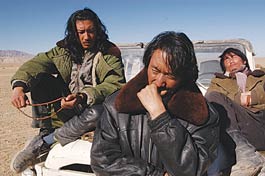home | metro silicon valley index | movies | current reviews | film review

Photo courtesy of National Geographic, Samuel Goldwyn Films and Columbia Film Production Asia
Kings of the wasteland: Duo Bujie (center) leads his troops into the wilderness.
High Plains Drifters
Chinese feature 'Mountain Patrol: Kekexili' proves that sometimes the best Westerns come from the East
By Richard von Busack
THE HIGH PLAINS of Kekexili, 4 miles high on the shoulders of the Himalayas, form the background for the extraordinary action film Mountain Patrol: Kekexili. It is a cinematically sweeping, yet lean and muscular work with the thrust of the best movies by William Wellman and Sam Peckinpah.
Has there been a secular movie about Tibet yet? Mountain Patrol: Kekexili may be the first. Director Lu Chuan is among the first generation of Chinese directors to study American studio films, and that may have something to do with the particular economy and compactness of this eastern Western.
His emphasis on the human scale might be seen as Chinese hegemony—that Mountain Patrol: Kekexili is trying to make Tibet look like a frontier, instead of ancient, sacred terrain. The film does not tell a story about lamas but of the Tibetan lower class, who band in patrols to save their antelopes.
In the mid 1990s, poachers were ravaging the herds of Tibetan antelope in a slaughter similar to the demise of the passenger pigeons, except that it happened much faster. Hunters reduced a population of perhaps a million animals to 10,000.
The purpose was to harvest the antelope's underwool, used to make shahtoosh, an ultrafine fabric prized in India. It takes three pelts to make one shawl. This "king of wool," as the Persians call it, can make cloth so sheer that a scarf made of it can be drawn through a wedding ring. Poachers with high-powered rifles and jeeps were picking off the antelopes at their breeding grounds, leaving the bodies to rot and the kids to starve. Tibetan patrolmen ranged out in trucks to try to intercept the smugglers. They were infrequently paid by the Chinese government and didn't have much legal power; all they could do is fine the poachers and confiscate the pelts.
In this fictionalized film version, one patrol is observed by a half-Tibetan, half-Han photojournalist from Beijing named Ga Yu (Zhang Lei). He joins the ex-army Capt. Ri Tai (Duo Bujie), who leads his troop of irregulars into the wilderness.
Explorers on Mars will get to see such landscapes. The vistas are luminously pristine, with razor-sharp peaks and flat lakes crusted with white patches that might be salt or snow. The area is wracked with deadly snow and dust storms. The Kekexili is supposed to be so vast that it is possible to be the first person to leave your footprint there. Cinematographer Cao Yu photographs with such clarity that you can see the buttons on an officer's greatcoat at 90 yards. And the use of wide-screen imagery is adept and telling, more than rhapsodic and dreamlike. The film looks harsher than our American Westerns have been ever since our directors started buying their vacation houses in the Rockies. The vultures feeding on the antelope carcasses are the most businesslike scavengers since the carrion eaters in The Wild Bunch.
Mountain Patrol: Kekexili shows its integrity in the suddenness of an ambush and during a foot chase between two staggering men, both near collapse from altitude sickness. And we get a sense of remorse in the image of a poacher's jeep that the rangers have set afire, to strand their human quarry out on the plains.
Against a landscape this vast, the film needed an iconic performance to hold the film together. As Ri Tai, Duo Bujie displays the intensity and compassionate toughness of a great cowboy star, complete with the leather-tanned face and great white teeth. But Chuan gets farther than the politics of the average cowboy movie by letting us understand the desperation of the poacher's life.
The Walter Brennan in the story is called Ma Zhanlin. He is a gentle ex-shepherd, lacy with wrinkles, who turned to crime because the land was drying up underneath his herds.
Where many directors head for those hills in search of spiritual healing, Chuan is more keen on the existential qualities of life and death in the high plains. While the focus is on steady, sure action, the movie shines with unaffected tenderness, especially in the scenes of parting where the men leave their village. It's as if it only suddenly occurs to the rangers that there's a good chance they might not be coming back alive.
Chuan's handling of the jhator (Tibetan sky burial) of a fallen mountain patrolman demonstrates how impassively tough he is. It is different from the way Martin Scorsese grossed the audiences with the exoticness of the corpse chopping in Kundun.
Here, as the monks drone and the birds fly in for their off-camera meal, the movie shows an iron-hard admiration for the ruggedness of a people who would invent such a practical ritual for sending off their dead. Being a hero when you know your fate is to line a vulture's gut: that's what Hemingway meant about grace under pressure.
![]() Mountain Patrol: Kekexili (Unrated; 90 min.), directed and written by Lu Chuan, photographed by Cao Yu and starring Duo Bujie and Zhang Lei, opens Friday, April 28, at selected theaters.
Mountain Patrol: Kekexili (Unrated; 90 min.), directed and written by Lu Chuan, photographed by Cao Yu and starring Duo Bujie and Zhang Lei, opens Friday, April 28, at selected theaters.
Send a letter to the editor about this story.
|
|
|
|
|
|